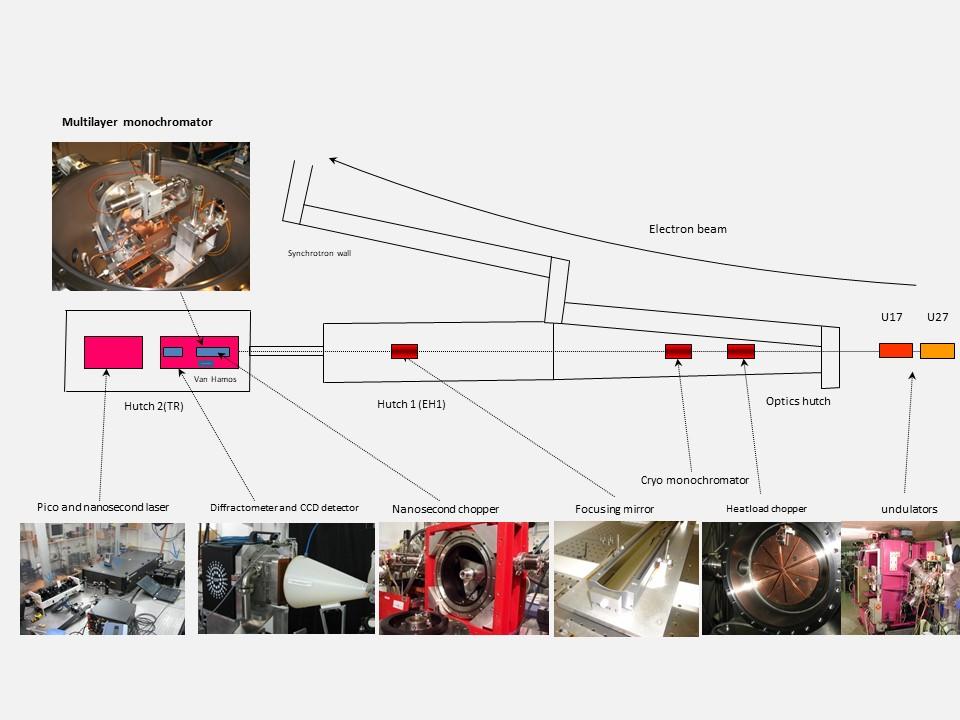ID09 is an undulator beamline for time-resolved diffraction, scattering and x-ray emission experiments. Most experiments use laser/X-ray pump-probe to "snapshot" transient states of the sample at a given delay between the laser and X-ray pulses. By varying the delay, the transient structure (or electronic state) is thus "filmed" with 100 ps time resolution. In addition a stopped-flow apparatus is available for probing irreversible reactions with 10 ms resolution.
The beamline can provide pink X-ray pulses of very high intensity. In 4-bunch mode for example, the U17 undulator produces 5 x 109 ph/pulse at 15 keV in a 4% bandwidth. The beam is focused to 45 um by a toroidal mirror. The pink beam can be monochromatised by a multi-layer monochromator with 2.0% bandwidth or by Si(111) or Ge(111) crystals between 8-24 keV.
The beamline has two choppers. The white beam is first intercepted by a heatload chopper that reduces the transmitted power to 12.5% (90 us pulses at 986.3 Hz) to relieve downstream components from high heatload. These pulses are focused to 45 um by a toroidal mirror. 1.5 m upstream the focus, the beam is intercepted by the Julich Chopper that can isolate single X-ray pulses from the 4-bunch, 16-bunch and 7/8+1 filling modes at 986.3 Hz. The pulse length of of X-ray pulses at the ESRF is 80-160 ps (FWHM).
The beamline has two laser systems for reaction initiation.A sapphire laser with 1.2 ps pulses that can be tuned by a TOPAS OPA in the wavelength range 265-1500 nm. That laser runs at 986.3 Hz. In addition, a 5 ns laser is available for protein reactions on slower time scales or for dynamic compression experiments at 1064 nm where the pulse energy is 350 mJ/pulse. The wavelength range is 354-1500 nm.
U17_invac, U27_inair
Cryogenic Si(111) channel cut monochromator 8-24 keV
heatload chopper and nanosecond chopper
From June 2018, one end-station EH2
Sample
Manipulator or Sample stage
X, Y & Z sample positioning
Sample Environment
2 different nozzles available, flat jet nozzle & round jet nozzle; liquid circulating
Tunable laser from 410 to 2000 nm (+ 355 nm); Up to 30 mJ pulse energy in visible
spectral range
▶ Less than 5 cm⁻¹ linewidth
▶ 3 – 5 ns pulse duration
▶ 10 Hz pulse repetition rate
For excitation of sample (liquid)
Together with 16GHz Oscilloscope, to time with x-ray-beam pulses
• Chirped Pulse Amplification scheme
• Integrated Evolution-30 pump laser, stretcher, regenerative amplifier and compressor
• Pulse width: 1-2 ps
• High energy, high efficiency design
• up to 3.5 W at 800 nm and 1 kHz repetition rate
For excitation of sample (liquid or solid)
Together with 16GHz Oscilloscope, to time with x-ray-beam pulses
Sample: liquid (up to 4 different liquids; for time-resolved experiments after rapid mixing)
Rayonix HS170
Detection
Chemistry lab
- Crystallography
- Crystallography (biological macromolecules)
- Powder diffraction
- Time-resolved studies
- Time-resolved studies
- X-ray fluorescence (XRF)
- Elastic scattering
- Small angle scattering
- Time-resolved scattering
- Wide angle scattering
- Other - Chemistry
- Other - Earth Sciences & Environment
- Sustainable energy systems
- Space
- Atomic & molecular physics
CS 40220
38043 Grenoble Cédex 9, FRANCE
- spec
- *.edf
- *.chi
- WAXSGUI (ESRF)
